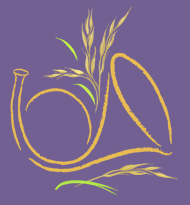Hair
Ballet Bun:

Unless specified, dancers should wear a ballet bun on stage. Other buns are called topknots, middle buns or low buns (romantic).
The Ballet Bun is positioned at the back of the head so that the very top of the bun is visible from the front. There is a diagonal line from the end of the chin, through the ear to the middle of the bun. It should end up rounded yet flat, not round like a ball.
To prevent fuzzies, completely wet hair and gather with a pony tail, twist and wrap, secure w/ long bobby pins or hairpins. Use a hair net (doubled) to keep bun smooth. And secure net w/ more long hair pins. Add hair gel before or after making bun, or both.
Do not use colored elastics or decorative head accessories. If needed for shorter pieces, use bend and snap clips that match hair color.
Ringlets:

Hot Roller Style
Hot rollers work well. They cool faster than hair dries. Make sure hair is dry for this style option and preferably not freshly washed. Dirty hair will style easier and hold better than freshly washed hair. Product is Key. Hot Sets by Redken is a favorite. Start about 2 hours before you need to dress to leave.
- Heat rollers.
- Have child sit in a chair (An office type chair that spins works well).
- Patience! This takes awhile. Make sure child is wearing a button up the front shirt or robe.
- Part hair down the middle.
- Starting at the top of the head in front near forehead section hair about the length of the roller — and about 1 inch wide — (depending on hair thickness).
- Comb through section of hair.
- Spray generously with product like Hot Sets (hair will get damp) both sides of the hair section.
- Comb again.
- Spray again.
- Roll hot roller into hair.
- Repeat continuing to roll each side of the head in the same direction meeting in the back. Do the top sections first then the lower part of the head.
- Let hair cool completely. (allow at least 30 minutes for a tight curl)
- Have snack and do make up while hair is cooling.
- After hair is cool begin to unroll hair starting with the lower sections of hair not the top. As you unroll the hair section, wrap the hair around your first two fingers continuing in a drown ward spiral. Hair should easily be adjusted to ringlet look.
- Do not separate or comb hair section.
- Continue around the head removing top sections last.
- Add hair pieces if applicable.
Sponge Roller Style
- Begin with wet hair.
- Pull back top of hair and side fronts into a clip or elastic.
- Roll remaining hair in sponge rollers, vertically around the head, in 2 or 3 rows.
- Allow to completely dry (air dry takes overnite and then some)
- Unroll gently, retaining the rolls, let hang, spray individually then all over.
- Attach bow to clip or elastic.
Dance Theatre Rules
- Use your 1" voice in dressing room
- No food in dressing rooms during show
- Limit use of aerosols; no perfumes please!
- Use dressing room stair rails and stay right
- No running during crossovers, or ever
- No talking on deck
- Never be seen waiting in the wings
- Give genuinely 200%+ on stage
- Freeze final poses until final Black Out
- Dance through and into the wings
- Dance in the Light
- Feel your toes and arms
- Don't fidget on stage
- After you exit clear the wings and return quietly to dressibg room
- After show, look behind you when leaving your dressing room and help get us quickly out.
Wardrobe & Make-up
Intermediate and above level dancers should own a flesh camisole leotard, a clear garmet bag, and standard stage make-up.
Younger dancers:
- Rose blush
- Light brown eye shadow
- Rose lipstick
- Mascara
- Browner blush
- Max Factor's stick foundation to match skin tone
- White, light & dark brown eye shadow
- Rose lipstick
- Mascara
- Eye liner
- Finishing powder
What dancers should eat for rehearsal and performance days
Performance week requires stamina, energy and concentration. Parents should pay particular attention to their child's diet the days of rehearsal and performance.
The Artistic Director recommends a good, hearty breakfast – bacon and eggs, oatmeal etc. to begin the day.
Avoid spicy foods immediately before performance, such as pizza or onions.
Bland foods are recommended and foods that they are already accustomed to – peanut butter sandwiches, chicken sandwiches, milk, cookies.

